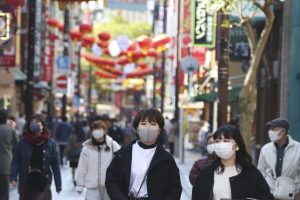The COVID-19 pandemic came by ship to Japan in February — a foreboding harbinger for a world that had not yet come to grips with the disaster to come.
The virus raced through a luxury cruise ship called the Diamond Princess after it had returned to its home port near Tokyo. A 14-day quarantine was imposed on the passengers, some of whom complained that they were being held in “a floating prison.” Of 3,711 people aboard, 712 were infected and 12 died.
Though Japanese health officials were accused of botching the handling of the ship, the country has weathered the pandemic well — it has been spared the dangerous surges seen in the U.S. and Europe thus far. By mid-December, Japan had reported 138 cases per 100,000 population.
Still, daily cases are now topping 2,500, prompting renewed fears that things will get worse.
Experts say widespread use of masks has been the key to reducing the caseload in Japan. The country has certain other advantages — people naturally bow instead of exchanging handshakes or kisses, and kick off their shoes at home. Public health care is affordable.
Authorities have installed a strong system for infection tracing, and the public has heeded calls to avoid the “three Cs” — close distance, closed space and close conversation.
“Quiet dining with a mask,” the Cabinet Office says on its website; a cartoon shows four people — a recommended maximum party size —dining with masks on.
One other key: Japan has kept its borders closed to about 150 countries since March and only recently eased rules on business trips between a few less-infected Asian countries, including Vietnam, South Korea, and Singapore.
Under a seven-week state of emergency through late May, Japan pushed its citizens to stay at home and maintain social distancing and asked businesses to stay shut, but there was never a hard lockdown. Many people defied the appeals and commuted on crowded trains and dined at eateries that remained open.
Patients, many of them elderly, filled hospital beds and medical systems were on the verge of collapse amid dire shortages of protective gear, but the infections leveled off in May and former Prime Minister Abe Shinzo proudly called it “the Japan model” of success.
Bullying and discrimination against the sick, health workers and their families have persisted, however, and fear of ostracism has often caused the infected to avoid seeking medical care.
The use of masks, widely accepted in Japan for protection from flu, pollen allergies, and other purposes even before the pandemic began, is standard practice on public transportation, inside stores, at work or school. And the government just launched a fresh mask awareness drive for an upcoming holiday season.
As elsewhere, infections have gradually climbed recently as Japan’s government tries to prevent the disease while avoiding further damage to the economy. Experts say the balance is now off and that business activity must be reduced to avoid explosive infections.
Fears of another, and possibly worse, surge have brought criticism from experts, opposition lawmakers, and the public that Prime Minister Suga Yoshihide’s government was too slow to suspend its GoTo campaign, which seeks to support suffering businesses by offering discounts for travel and eating in restaurants. Suga announced a suspension of the GoTo incentives only in hard-hit areas on November 21.
The increase in cases also calls into question plans to hold the Olympics next July. Any plan will have to be firmed up beginning in December.
Economy Minister Nishimura Yasutoshi said officials are on “maximum alert” and pledged to do the utmost to prevent another state of emergency. He reiterated the importance of using masks and avoiding parties where people drink.
“There is no doubt masks reduce the amount of the virus entering (the bodies), but we should not overestimate their effectiveness,” University of Tokyo virologist Yoshihiro Kawaoka said.
By Mari Yamaguchi for the Associated Press in Tokyo, Japan.
































